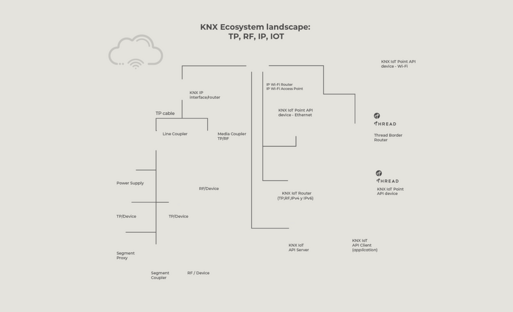
KNX IoT producten en oplossingen evolueren
slimmehuizen en gebouwen naar het volgende niveau.
Waarom KNX IoT?
- Interoperabel & veilig: KNX is de referentie als het over interoperabiliteit gaat. Neem gewoon twee gecertificeerde apparaten van eender welke leverancier en ze zullen gewoon op een veilige manier samenwerken op applicatieniveau. Volgens deze filosofie is KNX IoT ontworpen om het hoogste veiligheidsniveau te behouden. KNX IoT busdeelnemers hebben beveiliging ingebouwd in het ontwerp. Met deze robuuste nieuwe KNX IoT technologie kunnen fabrikanten en ontwikkelaars de beste apparaten, oplossingen en diensten bouwen die geïnstalleerd zullen worden door professionals in de sector van slimme huizen en gebouwen.
- Native KNX IoT apparaten (IPv6): KNX busdeelnemers gebruiken nu een nieuwe aanpak om in de IPv6 architectuur te passen. De nieuwe generatie KNX IoT busdeelnemers zal verbinding kunnen maken met IP netwerken (bekabeld en/of draadloos) om te communiceren met andere KNX IoT busdeelnemers en met klassieke KNX busdeelnemers die Twister Pair of Radio Frequency gebruiken.
- Gestandaardiseerde API: Apparaten die in een KNX-netwerk moeten worden geïntegreerd, kunnen dat nu dankzij een gestandaardiseerde API die verbinding kan maken met KNX-installaties. Deze API is eenvoudig, veilig, ontdaan van KNX-specifieke kennis en toekomstbestendig.
- Eén tool: ETS: Al deze mogelijkheden worden mogelijk gemaakt door het gebruik van ETS. Met ETS kunnen KNX busdeelnemers van meer dan 500 fabrikanten geconfigureerd worden, onafhankelijk van hun fysieke laag, en projectinformatie kan geëxporteerd worden naar om het even welke KNX IoT API Server met behulp van een verkopersonafhankelijke tool. ETS biedt kerninteroperabiliteit in een aantrekkelijke tool met een moderne gebruikersinterface.
- KNX, het grootste ecosysteem in huis- en gebouwautomatisering: Deze nieuwe mogelijkheid om te communiceren met behulp van de KNX-technologie zorgt voor meer flexibiliteit. Fabrikanten kunnen nu gebruik maken van nieuwe ontwikkelingsmogelijkheden om innovatieve producten en oplossingen te creëren; en professionals hebben meer mogelijkheden om een groter KNX ecosysteem in hun projecten te creëren.
Maak elk huis en gebouw slim met KNX IoT
Leer waarom KNX IoT een wereld van mogelijkheden opent voor slimme huizen en gebouwen in deze korte introductievideo.
Meer gedetailleerde video's en webinars over KNX IoT vindt u op ons YouTube kanaal.
KNX, het grootste ontwikkelingslandschap in zijn soort
Een baanbrekend ontwikkelingsplatform dat als basis dient voor opmerkelijke oplossingen is in 2023 aan de wereld gepresenteerd en maakt alle business cases in de smart home en building verticals mogelijk. Van enkelvoudige producten tot diensten, elke fabrikant of ontwikkelaar kan de nodige middelen vinden om unieke oplossingen te creëren.
Ontdek hoe het KNX Ecosysteem werkt door met de muis over de verschillende elementen in onderstaande afbeelding te gaan.
KNX IoT Ontwikkeling en KNX Startup Incubator
Geïnteresseerd in KNX IoT ontwikkeling? Ontdek meer over KNX IoT en hoe u kan ontwikkelen voor KNX IoT, de voordelen en de ondersteuning die KNX biedt via onze KNX Startup Incubator.
Reis met ons mee
Maak een MyKNX account aan om op de hoogte te blijven van het laatste nieuws in KNX IoT, technologische evenementen, innovatieve KNX producten en meer. Word lid van onze community voor toegang tot exclusieve inzichten en maak deel uit van de toekomst van duurzame energie. Meld u vandaag nog aan en blijf op de hoogte!




















